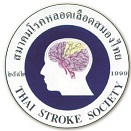Stroke campaign in Thailand with Neurological Research Foundation under Royal Patronage
Keywords:
risk factor of stroke, carotid duplex ultrasonographyAbstract
Introduction: Stroke was the leading cause of death and disability in Thailand. Knowledge and awareness of risk factors for primary prevention of stroke is the best strategy. Neurological Research Foundation under Royal Patronage in cooperate with Provincial Electricity Authority develop the program “Save your life, attention to stroke” for Provincial Electrical Authority employees and Thai. Objective: To study risk factors of stroke in Thai population. Material and Method: Cross-sectional study included Provincial Electrical Authority employees and Thai population in 5 provinces within 4 regions during 2017 with questionnaires, record blood pressure, body weight, height and carotid duplex ultrasonography to measure intima media thickness of carotid artery. Results: All participants were 1,728 cases, Provincial electricity authority employees 967 cases, Thai population 752 cases, mean age 56.8 years and 54.8 years, male 64 % and 39.7% respectively. Body mass index was 25.2, average blood pressure was 138/83 mmHg. Risk factors of stroke were snoring, dyslipidemia, alcohol drinking, hypertension, inadequate exercise, diabetes mellitus, ischemic heart disease and stroke. Intima media thickness more than 1 mm. were found 4-9.7% Conclusion: Risk factors of stroke in Provincial electricity authority employees were snoring, dyslipidemia, alcohol drinking, hypertension and inadequate exercise. Screening of intima media thickness was the option to assess risk of stroke
References
and 2004. BMC Public Health. 2011;11:53.
Hanchaiphiboolkul S, Poungvarin N, Nidhinandana S, Suwanwela NC, Puthkhao P, Towanabut S, et al. Prevalence of stroke and stroke risk factors in Thailand: Thai Epidemiologic Stroke (TES) Study. J Med Assoc Thai. 2011;94:427–436.
Nilanont Y, Nidhinandana S, Suwanwela NC, Hanchaiphiboolkul S, Pimpak T, Tatsanavivat P, et al. Quality of Acute Ischemic Stroke Care in Thailand: a Prospective Multicenter Countrywide Cohort Study. J Stroke Cerebrovasc Dis. 2014;23:213–219.
Tegeler, C.H., Ratanakorn, D. Carotid and vertebral duplex scanning in secondary stroke prevention and stenting. in: A.V. Alexandrov (Ed.) Cerebrovascular ultrasound in stroke prevention and treatment. Blackwell Publishing, New York; 2004:161–169.
Hanchaipibulkul S. Poungvarin N, Nidhinandana S, Suwanwela NC, Puthkhao P, Towanabut S, Tnatirittisak T, Suwantamee J, Samsen M.Prevalence of stroke and stroke risk factors in Thailand: Thai Epidemiologic Stroke (TES) Study. J Med Assoc. Thai 2011;94(4);427-36.
Areechokchai D, Vijitsoonthornkul K, Pongpan S, and Maeakhian S. Population Attributable Fraction of Stroke Risk Factors in Thailand: Utilization of Non-communicable Disease Surveillance Systems.OSIR 2017;10(1):1-6.
Downloads
Published
How to Cite
Issue
Section
License
ข้อความภายในบทความที่ตีพิมพ์ในวารสารสมาคมโรคหลอดเลือดสมองไทยเล่มนี้ ตลอดจนความรับผิดชอบด้านเนื้อหาและการตรวจร่างบทความเป็นของผู้นิพนธ์ ไม่เกี่ยวข้องกับกองบรรณาธิการแต่อย่างใด การนำเนื้อหา ข้อความหรือข้อคิดเห็นของบทความไปเผยแพร่ ต้องได้รับอนุญาตจากกองบรรณาธิการอย่างเป็นลายลักษณ์อักษร ผลงานที่ได้รับการตีพิมพ์ในวารสารเล่มนี้ถือเป็นลิขสิทธิ์ของวารสาร





